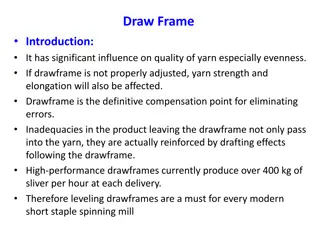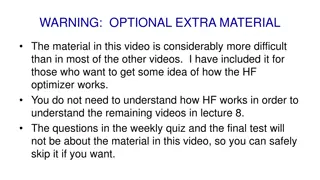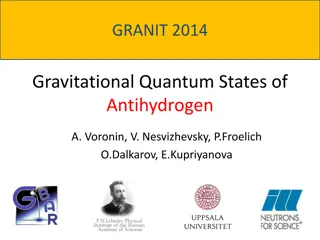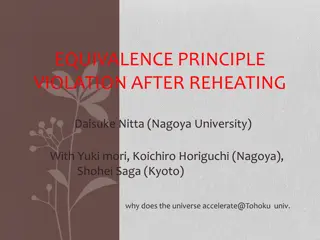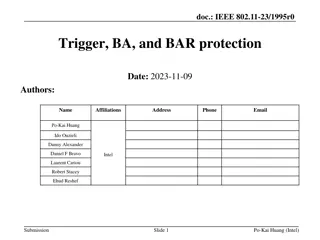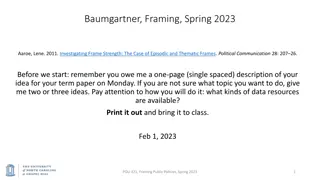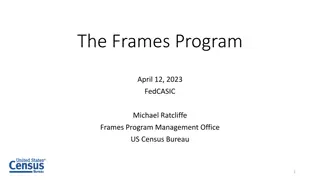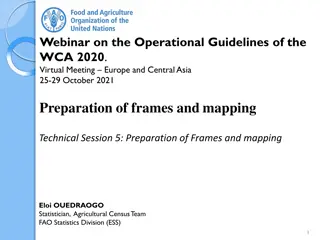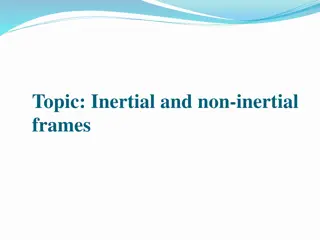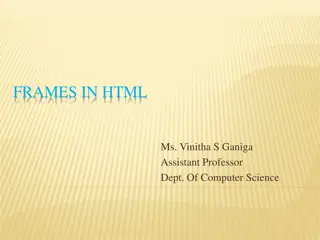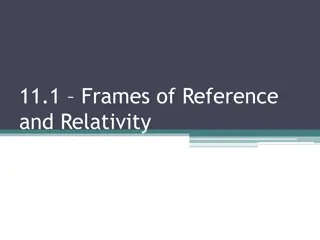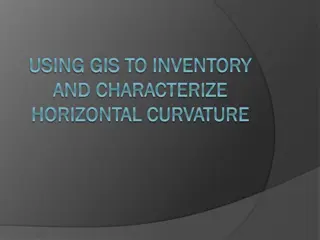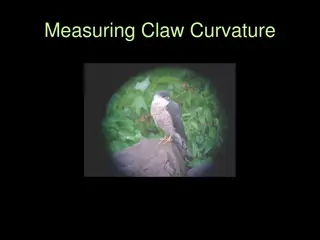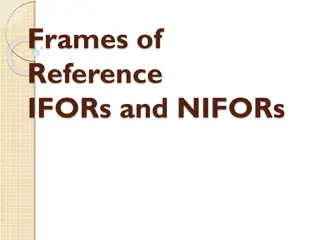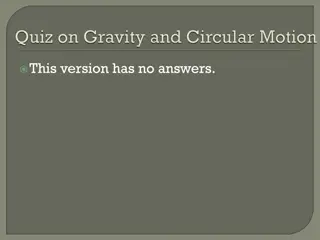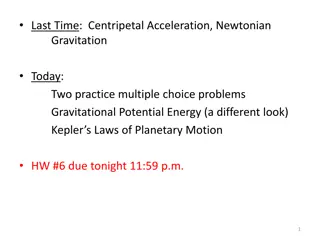Exploring Gravitational Effects and Space Curvature in Accelerating Frames
Explore the implications of equivalence in gravitational effects like redshift, time-warp, and space-warp in accelerating frames. Understand how the curvature of space is linked to non-uniform gravitational fields. Dive into observations confirming these phenomena, shedding light on the nature of space and time.
Download Presentation

Please find below an Image/Link to download the presentation.
The content on the website is provided AS IS for your information and personal use only. It may not be sold, licensed, or shared on other websites without obtaining consent from the author. Download presentation by click this link. If you encounter any issues during the download, it is possible that the publisher has removed the file from their server.
E N D
Presentation Transcript
Gravity and accelerating frames Implications of equivalence Is curvature necessary? Gravitational waves - space is real Geometry and Topology Does space exist Next time Cosmology Philosophical implications
Observational Consequences But if you can't tell whether balls fall to the floor because of g or because you have chosen an accelerated reference frame, then g must make those weird effects that we found for accelerated reference frames. Otherwise you could use them to test whether you were accelerating. So g should give the strange clock effects found in accelerating frames. One consequence is the Gravitational red shift The clocks at the bottom run slower than those at the top. One can use the frequency of light as a clock (count the crests as they pass by. The most accurate clocks work this way). So, do an experiment drop light from the top of a tower: Light becomes redder as it goes up and bluer as it goes down. (This can also be understood in terms of the energy of "photons".) The effect can be seen in starlight and also in buildings. (Pound & Rebka, 1960)
Space must be non-Euclidean in a non-uniform g, just as with non-uniform a. On the merry-go-round, where things would fly outward, C > 2 R. Near a star, where things fly inward, there must be the opposite effect, C < 2 R. (Here each length is measured with a meter-stick with some uniform construction, say same number of nickel atoms.) The result is a curvature of the paths of anything, including light, beyond that given by treating gravity as a force. (Doubles the curvature of light.) CONFIRMED, 1919 solar eclipse
Gravitational time-warp Classically, energy goes up as something falls. We ll see that corresponds to frequency. Clocks run faster away from the star, so synchronized processes like the wavefronts passing seem faster, measured by local clocks, below. The (locally measured) frequency of the wave is higher near the star, so the wavefronts are closer near the star. The wave must bend. This time-warp term is essentially just the classical force term, to a good approximation.
Gravitational space-warp On the merry-go-round, there was missing space inside the circle. Near a star, there should be the opposite effect. A wave passing by the star has to traverse more distance on the part near the star than on the part farther away. The wavefronts farther away get ahead, which turns the wave as if it were being pulled toward the star. That's the extra curvature of light observed in 1919. It looks like the wavefronts are closer together near the star, but that's only because I've forced the picture onto this nearly Euclidean page. Really there's extra space there and all the fronts are equally spaced, as measured locally. In a standard coordinate system (Schwarzschild) it s the radial lengths that are larger than you d think from the circumferential ones, giving extra curvature on the way toward and away from the star, not on closest approach. Note the necessity for an operational definition of distance (and time).
More Implications The new equations to describe the gravitational interactions are not the same as Newton's. We've now found experimental predictions which differ. The new equations used to describe how things look from accelerated frames and ones with gravity (i.e. all the frames which exist in the actual world) are called General Relativity (GR) GR also solved a long-standing problem. Remember way back when we were describing Newton's triumphs? The orbit of Mercury had been known since 1859 to deviate from its Newtonian prediction. The axis of the ellipse rotated, i.e., precessed. Many unsuccessful searches had been made for objects, such as other planets, that would explain the motion. GR correctly predicts the orbit. Notice how small the original problems were in the data. GR, unlike SR, was not the result of the attempt to resolve a burning issue. GR was driven by philosophical motivation.
Some confirmations of General Relativity SR background: Repeats of Michelson-Morley, good to one part in 1020. GPS devices positioning would drift off by about 7 miles a day, without GR corrections! Modern versions of the light-deflection experiment: repeatedly confirmed, now to better than 1% accuracy. Gravitational slowing of clocks: repeatedly confirmed, in one case to 0.03% accuracy. Time-delays affected by travel near sun: repeatedly confirmed to within 5% accuracy. Existence of gravitational lenses Probable existence of black holes Slowing of pulsar rotation due to gravitational radiation (quantitative) Gravitational waves from black holes observed on September 14, 2015! Gravity Probe B Frame-dragging around Earth (to ~20%) Earth s geodetic effect (reduced C/R) to 0.2%
Back to the twins What if Alice doesn't accelerate back toward Earth using rockets, but instead just slings around using gravity from some big planet? She feels no accelerations, at least not like she would feel a non-gravitational force. So we can't argue anymore that the one who's younger is the one who "feels no accelerations"- neither twin feels any accelerations. Nonetheless, Alice is younger, because she spent time DOWN in the gravitational field of that big planet, so her clocks were all running slow. The only evidence she would feel would be that clocks on one side of her ship would run faster than the other- an effect down by a factor of ship size/orbit size from the twin effect. You can see G.R. outgrow some of the arguments which led into it. Now we are abandoning the deconstructive phase of asking what traditional constructs are not required by experience. We've got a new theory, and are cranking out results to see if the predictions agree with measurements, not worrying about the philosophy.
Do we need curved spacetime? Just to be sure it is clear: The 2-d examples of curved surfaces allow us to look at things from outside. However, a 2-d person confined to the surface and with no knowledge of the 3rd dimension could still infer the curvature from his own geometrical measurements (e.g., the angles of triangles). That s the situation we find ourselves in. The curvature can be completely defined and all experimental predictions, etc. made with no reference to some other dimensions. This claim does not mean that no other dimensions exist, just that they are irrelevant to the question of whether our familiar dimensions form a flat space. The immediate question is do we need curved spacetime, or can we get away with flat geometry? (Sklar, 55-67) We have already seen that if we want to put accelerated observers on a par with inertial ones, we need curvature. If we don t do this, then we need to say that the forces accelerated observers experience are pseudoforces akin to the centrifugal force. Are these two views equivalent?
Digression into Geometry Status of geometry and logic Euclidean vs Non-Euclidean Geometry Topology Is space real? Sklar Space, Time and Spacetime pgs. 13-46; Philosophy of Physics pgs. 53-91
Egyptians developed geometry as a practical science. Greek geometry culminated in Euclid s work (300BC) Starting from definitions, axioms, postulates, logic one derives theorems: a2+b2=c2 Definitions relate words to the reader s intuition a line is an element of length with no breath. No physical object is a perfect line. How to define? Axioms are common notions (logic). Postulates relate to geometrical ideas.
Euclid Axioms: 1. Things equal to the same thing are equal to each other. 2. Equals added to equals yield equals. 3. Equals removed from equals yield equals. 4. Coincident figures are equal to one another in all respects. 5. A whole is greater than any of its parts. Postulates 1. Two points determine a straight line. 2. A straight line may be extended in a straight line in either direction. 3. About any point a circle of a specified radius exists. 4. All right angles are equal. 5. If a straight line falling across two straight lines makes the sum of the interior angles on the same side less than two right angles, then the two straight lines intersect, if sufficiently extended, on that side. OR 5. Through a point outside a given line one and only one line can be drawn which does not intersect a given line, no matter how far it is extended.
There are further implicit assumptions: Notion of a limiting operation, e.g. the area and circumference of a circle. Why are the postulates true in our world? Especially the 5th postulate. Why is logic or the procedure correct? Euclidean geometry is a paradigm of the deductive method. Can/should we make physics like geometry? Straight lines can be constructed once we have a straight edge. Empirical fact: do lines meet? Definition: what is a line?
Further developments Descartes(1596-1650) related geometry to algebra P=(x,y)=r straight line: a.r=b Circle: (r-c)2=d2 We don t have to draw pictures but only manipulate symbols. But what do the symbols mean in the real world? Calculus developed by Leibnitz and Newton allowed more general objects than lines and circles. Newton: geometry is the simplest science. It is empirical! Leibnitz (Plato) the axioms are self-evident Kant: Geometry formulates the structure of our senses.
Non-Euclidean Geometry Is the 5th postulate derivable from other assumptions? There were many attempts during 2000 years but no success. In the 18th and 19th century, non-Euclidean geometries were constructed. Replace the 5th postulate by: No parallels (Reimann): Through a given point outside a line all lines intersect the first line and they are of finite length Many parallels (Lobachevski and Gauss) An infinity of lines can be drawn from a given point without intersection. Sphere: Saddle: "triangle" "triangle"
How to prove alternate geometries are consistent Relate them to a known consistent theory. Map them into algebra like analytic geometry Riemann geometry in 2D is like spherical geometry in 3D. Every statement in Riemann geometry is translated into a statement in spherical geometry. QED Riemann Point Line Triangle distance Euclid Point on a sphere Great circle Spherical Triangle Arc length Hence: alternative geometries exist!!
Hilbert (1898) axiomized geometries much more explicitly than Euclid did Everything was defined in terms of primitives: points, lines, planes . By removing axioms one-by-one, many types of geometries can be constructed Definitions is a process whereby new terms acquire meaning in terms of primitives. Hilbert can disentangle the Euclidean system. Not only is the 5thpostulate arbitrary.
Gausss (1777-1855) Curved Geometry Altitude should not enter in. (E.g. The surface of the earth.) Define coordinates as a continuous family of curves, a grid Geometry is speciifed by a distance metric g12(r) Define a geodesic as the shortest path between 2 points. Generalization of a line. a2+b2 =c2??? There can be multiple lines between 2 points (consider circles from the north to south pole) Geometry is locally Euclidean: small triangles obey Euclid s laws. There is an intrinsic curvature determined by angles and distances within the surface. In a homogenous space g is constant everywhere. But specifying g is NOT enough. We must also specify the topology. A plane and the surface of a cylinder are both Euclidean but they are different. They can only be distinguished by global measurements.
Choices of Coordinates 0 1 2 3 4 5 6 7 8 9 10 Either of these grids (black or blue) is OK! How can you keep the same laws of physics? Distances are a function not just of the difference in the coordinate labels but also of a metric tensor field defined at each coordinate point. That s not an increase in complication because gravity already required some sort of field like that. 0 1 2 3 4 5 6 7 8 9 10
Topology Curved geometry allows different connectedness, i.e. topologies , e.g. how many holes. Consider a cylindrical universe: t The local geometry of a cylinder is flat, but one coordinate is cyclic. If our universe had this topology, there would be a preferred reference frame, the one with the time axis along the cylinder, as shown. This is an example of the situation not manifesting the symmetry of the physical laws. x Would this mean that Galilean relativity is wrong? Is the geometry of the universe a law or just a fact ? Consider a donut universe (not valid): The local geometry is curved. The time coordinate is cyclic. How can one distinguish past from future here? What about causality? t x There may be valid solutions to GR with this problem.
Is Euclidean geometry correct? Plato: The sensed world is an ephemeral approximation to the true world of ideal essences. Reason tells us more about that true world than mere sensation can provide. Aristotle: the fundamental propositions are self-evident. Hume (1711-1776): Whatever we claim about reality, only senses are available. There are 2 types of statements: A priori: the only unpack meanings of words All bachelors are unmarried A posteriori can be rejected in light of experience. Kant (1724-1804): There are non-trivial a priori propositions; meaningful statements that are irrefutable. There exists a real world; sensations come from outside therefore there exists an outside. Our perceptions are structured by our mind Space and time are a priori. We can t imagine a world without time or space. We can imagine being blind or deaf but timeless? Statements are irrefutable because that s how we think about it.
Empiricist position Anything meaningful can be refuted. Geometry is an experimental science. What is a line? We need an operational definition. A straight edge (rulers can bend) A beam of light (light diffracts) What is a point? Numbers describing where to put an infinitely small particle. But particles have a definite size and we can t measure their position to arbitrary accuracy. Quantum effects limit us. Maybe the underling reality is discrete. Coordinates should not be continuous but integer like street addresses. Is there always a point between two other points?
Poincar parable Consider a 2d world of a disk. Measuring sticks are sensitive to temperature but if gets colder the further out you are. Length = R2-r2. They think the disk is infinite since their sticks can never reach the edge in a finite number of steps. Space is Lobachevski with negative curvature. Suppose they have light rays with index of refraction 1/(R2-r2). Same conclusion. How do we convince them that the world is really Euclidean? Poincar (1854-1912): Any geometry is possible. Decide on the basis of convention or convenience. Since Euclidean geometry is simpler, use it. Einstein: Beams of light define geodesics. Equivalence principle implies space-time is curved.
Empiricist reply to Poincar (Eddington, Reichenbach) Alternative geometries can always explain any new data. We can save Euclid by convention. This is a trivial reworking of the meanings of length and time. If predictions are the same, the theories are the same. In physics we define what we mean by length. Then there is a real distinction between Euclidean and non-Euclidean geometries. If we say rods shrink and expand that is a new definition. Poincar must introduce universal forces, something that shrinks all lengths . There is an interconnection between geometrical laws and physical laws. How about the topology of space? Is that convention?
TAXONOMY OF BELIEF IN GEOMETRY Disbelievers: everything is theory, even definitions of length Believers in observational basis Reductionists: theory=observation, alternatives are rewordings. Antireductionists: theory is more than observations Skeptics: no rational choice is possible between alternative theories. We may never know what lies beyond our measurements Conventionalists: simply choose a theory. There is no true reality only convention. A priorists: choose a theory on the basis of simplicity, elegance, initial plausibility
What will our straight lines be? If a good definition of a straight line is "the path followed by an object which experiences no forces" we must recognize: Gravity is not experienced: in principle a gravitational field cannot be felt locally. A straight line would then be a path followed by some small object in the presence of no influences other than gravity, i.e. in free fall. These are called spacetime geodesics This is the non-Euclidean generalization of Newton s 1st law. A geodesic is defined to be the shortest line between two points on a surface. In spacetime, this is generalized to be the world line which has the largest interval between two events (4-d points). ( Largest is an artifact of the - sign.) ct Stay-at-home sister's interval is greater than her travelling sister's. x ct On the sphere there are no parallel lines. All geodesics intersect. Similarly, the interpretation of the trajectory of a dropped ball near the Earth is that its world line appears to start out parallel to the Earth s, but inevitably intersects it. x
Is space real? If GR forces us into non-Euclidean geometry, does this require that space is real ? A relationist would say that this only implies that the geometrical relations between objects is not what we thought. No substantive spacetime is required. However, there are two new substantivalist arguments. In GR the gravitational interaction between objects is mediated by the geometry. That is, geometry plays the same role as, e.g., the electric field. An object distorts the geometry in its vicinity. This distortion affects the motion of other objects, because the geodesics are modified. Thus, spacetime plays a more direct role in the dynamics than in Newton s physics. Finite propagation speeds give fields more of a reality in SR (and GR) than they had before. We already saw quite dramatically in electromagnetism, in which wave motion of the fields was predicted and then observed. GR makes a similar prediction for the gravitational field. If the Sun were to move we would feel the changed gravity at the Earth 500 seconds later. As the Sun shakes back and forth, say as the planets orbit, GR says it would emit gravitational radiation (waves) with many of the same properties of EM waves. Gravitational waves are as real as any other object. They carry energy and momentum. They have recently been observed.
Relationist vs. substantivalist Space-time seems to have observable properties in itself, like electromagnetic fields, etc. These properties are far from resembling those expected for Newton's space. Einstein's original motivation was to develop physics that followed Mach's principle, but GR does not follow that principle. (And Mach was unable to follow SR, much less GR.) It may be possible to add Mach's principle as a separate requirement, i.e. to rule out those GR spacetimes which do not obey Mach's principle, but nothing about the structure of GR itself tells you to do so. Newton said (in effect) that two masses tied together and spun would stretch a string taut, because they would need a force to keep them both accelerating toward the middle, regardless of the condition or existence of anything else. They have "absolute acceleration". Mach said the string could not go taut because "absolute acceleration" is meaningless- you need the other stuff in the universe to create the forces. Einstein abandons the phrase "absolute acceleration", but GR allows solutions in which the string is taut. Such a solution can either be described as two masses rotating in nearly flat space-time or as a strange twisty space-time exerting peculiar gravitational forces. But operationally, Newton and Einstein agree on what the possibilities are, and they include the possibilities excluded by Mach. GR outgrew its philosophical ancestry.
Some conceptual implications Spacetime is beginning to become more substantial than it was (contrary to Einstein s original motivation). The geometry of spacetime varies from place to place in a way that is observable. We ll see next time that it s even more real than this. Elevating unexplained coincidences (the equivalence principle) into general postulates succeeded again. Will it work in general? Geometry is empirical. Kant was wrong that it was only possible to conceive of the world in Euclidean terms. The world violates Euclid's axioms.
Global vs. Local They are equivalent locally (if no singularities), but not globally. Only special configurations of gravity (uniform gravity, for example) can be completely eliminated by going to an accelerated reference frame. In particular, nonuniform gravity gives tidal forces which can t be transformed away. One can maintain flat geometry if one attributes effects such as the slowing of clocks to dynamics (similar to the pre-SR Lorentz contraction, etc.), but that gains one nothing and is vulnerable to the same criticism (it s ad hoc) that Einstein made of the pre-SR theories. Imagine the universe really had the topology of a sphere, that has global consequences (e.g., one might be able to go around) which can t happen in flat space. The large scale geometry of the universe is still not known. (More on this later.) However, it has been shown mathematically that the geometry must have at least one singularity- an infinite deviation from the simple flat-space picture- which would be extremely hard to mimic in a flat-space model. Furthermore, GR makes many detailed predictions which have been beautifully confirmed, and which beat the predictions of a whole slew of rivals- most of which also have curved space, anyway. There is no competing theory with the same simplicity and predictive power, except theories whose predictions are already known to be wrong.




